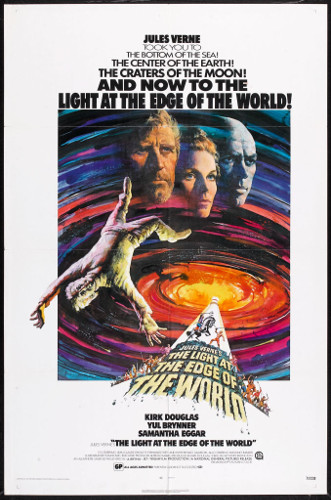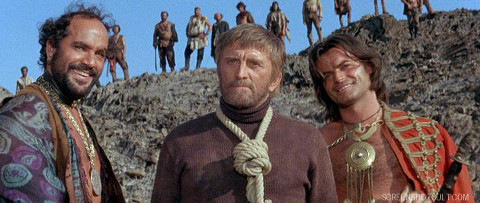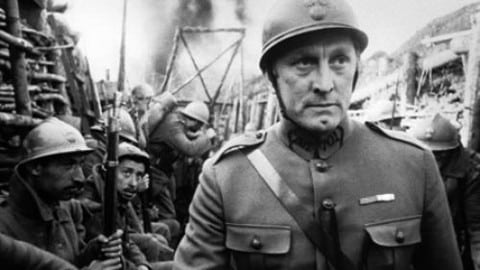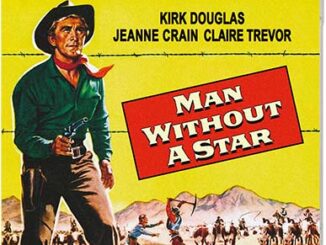The Light at the Edge of the World (1971)
Directed by: Kevin Billington
Written by: Berta Domínguez D., Jules Verne, Rachel Billington, Tom Rowe
Starring: Jean-Claude Drouot, Kirk Douglas, Samantha Eggar, Yul Brynner
USA/Spain/Liechtenstein
AVAILABLE ON BLU-RAY [Region ‘A’ only] AND DVD
RUNNING TIME: 123 mins
REVIEWED BY: Dr Lenera, Official HCF Critic
1865. A lighthouse situated on a small desolate island off the coast of the southern end of South America is managed by keeper Captain Moriz and his assistants Phillipe and Will Danton, an ex-gold prospector haunted by a troubled past. One day Moriz espies a band of pirates heading for them. He and Philippe go down to meet them but are murdered. The pirates, led by the rather mysterious Jonathan Kongre, take control of the lighthouse and intend to use to lure passing ships on to the rocks with a false light so their inhabitants can be slaughtered and all their worthwhile belongings taken. However, there’s the small matter of Danton to deal with….
So Kirk Douglas has passed away after a very long and rich life, and I decided to attempt to cram in to my schedule a review of one of his movies, but opted to go for one of his more offbeat, lesser known efforts. Unlike the other and much more popular Douglas-starring Jules Verne adaptation 20 000 Leagues Under The Sea, The Light At The Edge Of The World is a film I thought to be so obscure that it perhaps shouldn’t even be regarded as cult, and I even had trouble finding half decent pictures from it, but it’s had three DVD releases and recently one on Blu-ray in the States, so maybe this movie, which is really an early version of the Die Hard template in some respects, does have a substantial following after all. It’s rather strange, an extremely downbeat – in fact thoroughly nihilistic – outdoor thriller rife with nastiness, people acting just plain oddly and peculiar details which doesn’t entirely work but is certainly interesting. I recall the time when I was very young and seeing the trailer for a TV showing and, thinking it was for a Western, begging my parents to allow me to stay up late and watch it, which they did. I actually found the film quite upsetting but was fascinated by it none the less. Subsequent TV showings I always watched – even though the movie was unsatisfying, something made me always see it again. Watching it on DVD for this review with a more critical eye, it’s flaws were laid bare. It’s something of a mess and at times seems to drag out its running time for little reason where it could have been spent fleshing out details especially the motivations of some of the characters, but it’s often surprising and has a certain grim effect which you probably won’t forget for some time.
Jules Verne’s novel The Lighthouse at the End of the World was first published in 1905. One of his lesser known works, a film version was originally announced as a major Columbia release in 1962 to star Hardy Kruger and Jean Marais. The project was then reactivated in 1969 by Douglas’s production company Bryna Productions, which made the film with Spain’s Jet Films and Triumfilm, Liechtenstein’s Lubic Productions, and Alexander Salkind. After Cy Endfield turned down the job of direction, it went to Kevin Billington, chiefly of little know TV movies [though his psychological horror Voices is worth seeking out and I think I’ll review it sometime soon], possibly because he was fluent in Spanish, while the screenplay, which much hardened the novel and added the character of Arabella, was written by Tom Rowe, Berta Dominguez, and the director’s wife Rachel. The island the action takes place on was a combination of seven different locations all over Spain, while the lighthouse was specially built. The film was originally intended as a roadshow release, a practice in which a usually long movie opened in a limited number of cinemas in major cities around the world for a specific period of time before the general release and which in this version had an intermission. But in the end National General Pictures only gave it a minor release in the US where it lost ten minutes of violent and dark content to get a ‘PG’ rating. Elsewhere, it was released more widely by MGM and sometimes in varying cuts, with the UK version also losing around ten minutes to get a lower rating, though the film’s unkiddie-friendly feel and tone would have remained. It got little attention and flopped. The UK DVD is still missing not just a horse fall but, for some reason, the entire scene surrounding it.
So we’re on a ficticious unnamed island set in the geographic location of the Tierra del Fuego archipelago at the southern tip of South America, though to be honest this island could be situated virtually anywhere. The opening shot of a hugely obvious model boat doesn’t really get things off to a good start – it’s best to wait a bit before the obvious fakery commences – then we see Danton being dropped off at the lighthouse. We get ten minutes or so of scene setting, with some distinct tension between Danton and Moriz, the latter thinking that the former is not a very good assistant lighthouse keeper. Fernando Rey, the very fine actor playing Moriz, seems to be dubbed by Robert Rietty ,the same guy who dubbed Adolpho Celi [Emilio Largo] and Tetsura Tamba [Tiger Tanaka] in Thunderball and You Only Live Twice respectively. He’s not listed on the credits but it definitely sounds like him. Anyway, after the ominous discovery of a skeleton floating in the water, the pirates soon show up. Moriz and Philippe go to investigate, and the pirates welcome them onto their boat – and then murder them in quite a shocking moment, all the more effective because it’s shown at a distance from the point of view of Danton who’s watching with his telescope. Danton is soon caught himself, as is Philippe’s little pet monkey, a character who appears to fill the role of light relief, until we get the bit which rather upset me as a wee lad. We get the impression that the pirates are going to cook the monkey and it’s taken away. Danton is strung up against the lighthouse and swung back and forth for what seems like ages, and, from his upside down point of view, we see the guy who went off with the monkey appear again and seem to stab it. It seems that this is going to be it, but then when we cut back to him we see a graphic and quite convincing shot of the monkey being gutted, not something you would often see in a film, at least until the Italians started making their cannibal movies where, as we know, much of the animal violence wasn’t even faked – it was real.
Kongre could easily kill Danton there and then, but of course he wants to have some fun with him instead, so he releases Danton to be chased by him and his men in a sequence which gets unintentionally amusing when Danton and the pirates are sneaking around in full view of each other. Honestly – it’s hilarious to see. Kongre soon regrets his decision when Danton starts to wage a one-man war against the pirates who turn out to be wreckers, brigands who use the lighthouse to mislead ships into the rocks so they can kill the crew and passengers and loot the cargo. He saves one victim-to-be, Montefiore, and the one man becomes two. It’s gripping at times, but eventually the film begins to ‘lose it’ somewhat with the introduction of another shipwreck survivor Arabella. Kongre forces her to dress up as Danton’s lost love, presumably to lure Danton out of hiding, though why on earth does he go to all this trouble when he doesn’t actually set up much of a trap – nearly all the pirates are elsewhere? And why does Danton only realise it isn’t who he thinks it is after he’s kissed her – is his memory that bad? It gets a bit confused, as if portions of explanatory dialogue have been removed to speed things up, even though this is one film that could really have done with some tightening here and there. At least things pick up considerably towards the end, and we get not one but two surprises concerning Arabella which are downright mean spirited – meaning of course that I love them. The much anticipated battle between Danton and Kongre isn’t really the thrilling, vicious brawl that you’ll led to believe it’s going to be despite both Douglas and Brynner looking like they’ll be up for it and the lighthouse setting. It begins well with Kongre throwing lots of things at Danton, but then just ends in a silly fashion with a very obvious ‘fall’.
Indeed for every well done moment or idea, you get an equal amount of sloppiness, like a brief flashback which gives us some background detail about Danton but which is very awkwardly placed and then made redundant when Danton tells somebody what happened anyway. There’s some really laughable day for night footage, plus a terribly recorded soundtrack. You can just about make out composer Piero Puccioni’s two main themes – an appropriately melancholic main one which seems to evoke Danton’s state of mind, and a love theme – but half the time the music sounds so poor that it sounds like it’s done on a poor synthesiser even though it’s orchestral. By contrast the cinematography by Henri Decae can only be admired because of how hard it would have been to shoot well on the craggier locales. Many of those rocks look deadly! There’s an almost surreal quality to many of the scenes with the pirates who are a truly bizarre bunch. Some of them resemble South American Indians, while others wear a peculiar variety of costumes from various cultures and time periods, carry an odd array of weapons, and spend much of the time laughing in a really evil fashion at their captives and even making animal sounds which makes some of these moments quite unnerving. Former slave merchant Kongre is not only a sadist but also keeps a young black boy as not just his slave but, it is implied, as his lover. He also rides a horse with a unicorn horn stuck on it. His first mate Virgilio does crazy dances [and almost loses his life when the actor accidentally slips over, a shot left in the film], is a cross dresser and a homosexual, and he and Kongre both like to wear women’s jewellery. Nonetheless, the film’s depiction of the brutality of its villains is a praiseworthy corrective to the more common portrayals of pirates in movies as likeable rogues [Jack Sparrow wouldn’t last a minute against this lot], and I don’t know why we continue to see pirates in this manner – though the TV series Black Sails was a surprisingly realistic, unvarnished depiction some of the time.
Billington makes good use of the landscapes but some major scenes are all-but botched, like the ship massacre. Cutting away from the violence to show some other passengers witnessing it might have worked if they didn’t have oddly coloured blood on their faces. A severed hand and a flaying do provide some more shocks elsewhere. Brynner seems to be on autopilot but of course still possesses that incredible screen charisma that he never lost even when he obviously felt that he was slumming it, while Samantha Eggar visibly struggles with having such a dumb character to play. However, one of the other things I really do like a lot about this film is Douglas, who isn’t at all the brash, womanising hero you might expect him to be going by other roles in superficially similar films. He still projects considerable toughness – you really believe Danton could survive the ordeals he goes through even though Douglas is 57 – but Danton is also a tortured, emotionally vulnerable soul. Douglas plays some of his strongest moments with unusual subtlety for an actor who tended to be very external, such as in his final scene with Arabella where the viewer is made fully aware of his feelings without having it all spelt out. I’ve come to the conclusion that this is actually one of his best performances, so am fairly pleased that I chose this film to review despite its many problems. Eccentric, callous and rather pointless, yet interesting and with the signs of a truly impressive work in there somewhere, The Light At The Edge Of The World is a cult movie in waiting – or maybe it already is a cult movie? Anybody else out there?











Light at the Edge of the World I first saw as a young teenager, a bizarre and often brutal film, I recall how many of the pirate gang I had seen in ‘spaghetti’westerns of the same era. One actor Victor Israel was in The Good the Bad and the Ugly. Its a slow burner that would make most folk fall asleep after 10 minutes but hang in there it is a worthwhile watch if you like something different with a European feel as opposed to Hollywood. How it was marketed as a family adventure I’ll never know, it must have been an admin mistake, some scenes are quite disturbing, the pirates are truly demonic. Their leader played by Yul Brynner is the most interesting. He presents himself as an educated individual suggesting an aristocratic background, but it masks his viciousness. In stark contrast, his gang are a common mish mash of South American indians,Latin Americans&Europeans, the latter adorned in the more exotic traditional pirate attire. Unlike their leader, their overall demeanour is that of a pack of animals… Swiss Family Robinson or Pirates of the Caribbean it is not..
A light at the edge of the world is the stuff nightmares and pure horror derive from. Demonic Barberic evil personified ! I enjoyed the little chattering man immensely. This film was made in spite of its obvious flaws with some of our greatest actors/ actresses ! Jules Verne would have loved it ! And also hated it .
First movie approval ( Executed in a sensible adult manner) should commence with character narrative assessment
and whether I , as an audience of ONE is drawn in to care about characters, or not ? Who will and who will not suffer and or die ? This story moved me to depart the viewing !